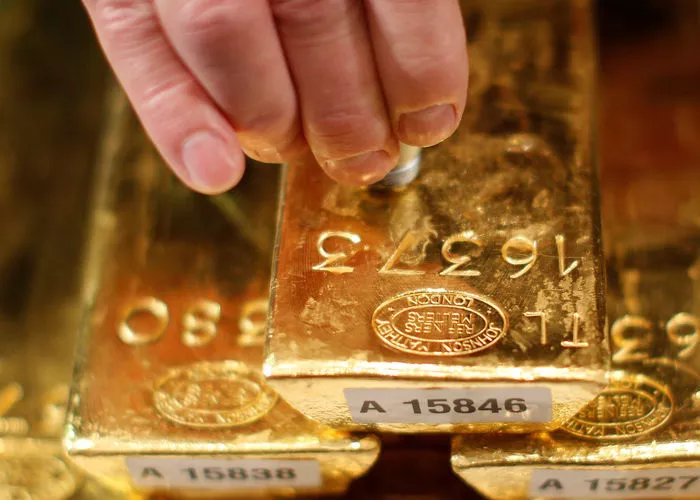Gold prices have reached new heights as President Donald Trump’s tariffs continue to create ripples across global markets. While Trump’s economic policies, including a 25 percent tariff on steel and aluminum imports, have affected various sectors, they have also led to a surge in the price of gold, a traditional safe-haven asset. This spike in gold prices raises questions about the broader impact of such economic moves and why gold tends to climb during times of uncertainty.
Gold Prices Reach Record Highs
Gold prices recently hit record levels, with the precious metal breaking the $2,900 per ounce mark for the first time. By Tuesday, it had surpassed $2,942 per ounce, marking a significant increase. As of 07:01 GMT, spot gold stood at $2,916.37 per ounce, having briefly touched a peak of $2,942.70.
The surge follows President Trump’s tariffs, which have unsettled markets and driven investors toward assets perceived as safer during periods of instability. Experts suggest that this trend points to a growing preference for gold as a secure investment amid escalating global economic uncertainty.
Why Gold Is Viewed as a Safe Asset
Gold has long been considered a safe haven for investors, especially during times of political or economic turmoil. Unlike paper currencies, which can lose value due to inflation or excessive printing, gold has historically retained its value. It is a finite resource with tangible uses, making it less susceptible to the volatility that can affect national currencies. Additionally, gold is universally accepted, unlike country-specific currencies.
The World Gold Council (WGC) notes that gold is highly liquid, free of credit risk, and maintains its value over time. These qualities make it an attractive option for investors seeking stability in uncertain times.
Historical Context of Gold Price Surges
The price of gold has seen significant spikes during past global crises, reinforcing its reputation as a safe asset. In 2008, amid the housing crisis in the US, gold briefly fell before stabilizing and climbing to record levels. By September 2011, the price reached nearly $1,900 per ounce as the world dealt with the aftermath of the financial meltdown.
More recently, the Russian invasion of Ukraine in 2022 triggered a surge in gold prices, with prices rising to over $2,070 per ounce amid growing inflation concerns and the volatility in oil and commodity markets.
Trump’s Tariffs: The Trigger for Gold’s Rise
This latest surge in gold prices can be traced to President Trump’s recent tariff actions. On Monday, he reinstated a 25 percent tariff on steel imports and raised aluminum tariffs to 25 percent, up from 10 percent. Additionally, he removed exemptions on products that use these metals and eliminated certain quota deals.
Trump’s rhetoric emphasized the need for the US to produce its own steel and aluminum, citing national security concerns. He also paused plans for broader tariffs on imports from Canada and Mexico, two of the US’s largest suppliers of these metals. However, he moved forward with a 10 percent tariff on Chinese imports, signaling continued trade tensions with China.
Trump’s actions, coupled with his aggressive economic rhetoric, have further unsettled global markets. Experts believe these moves will likely lead to retaliation from US trading partners, especially in Europe and Asia.
Global Reactions to Tariffs
Trump’s tariffs have sparked responses from around the world. Canadian Prime Minister Justin Trudeau described the tariffs as “entirely unjustified,” pointing out that Canadian steel and aluminum are integral to many US industries. He assured that Canada would take a firm stand in defending its industries and workers.
In China, authorities have already imposed their own tariffs on a range of US imports, including coal and crude oil, in retaliation for previous trade actions. According to Gabriel Wildau, senior vice president at Teneo, the new tariffs may not lead to an outright trade war but are likely to result in retaliatory sector-specific tariffs from Europe and Asia.
Other Economic Impacts of Trump’s Tariffs
The market response to Trump’s tariffs has not been limited to gold. Concerns about rising inflation, driven by both the tariffs and tax cuts, have led to an increase in the value of the US dollar against most global currencies. However, the economic volatility has also put pressure on global markets.
Asian steelmakers saw their shares fall, with some dipping by as much as 2.62 percent. Futures for iron ore, a key material for steel production, also experienced fluctuations, as traders weighed the impact of the tariffs against weather-related supply disruptions in Australia.
In the wake of these developments, Asian markets have been notably jittery, with traders on edge over what Trump’s next move might be. As the global economy continues to adjust to the fallout from these tariffs, gold remains a key asset in the ongoing search for financial stability.
Related topics:
- India Surpasses China in Gold Purchases, Buying 51% More in Three Months
- Gold Rates Skyrocket in Chennai on Diwali, 24K Gold Exceeds Rs. 81,000 Per 10 Grams
- Maryland Considers Exemption for Insurance Premium Loans in New Disclosure Law


